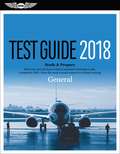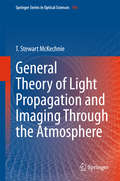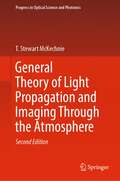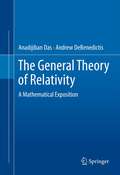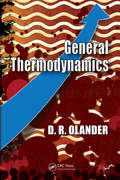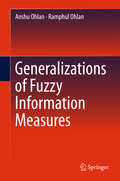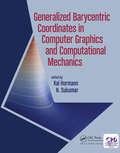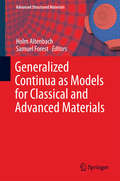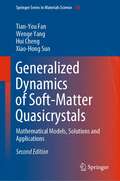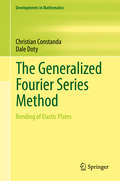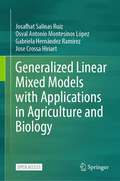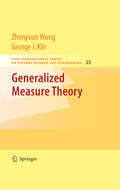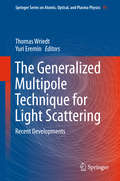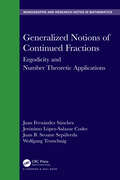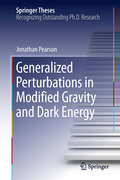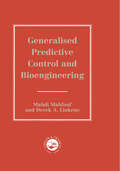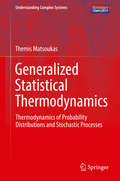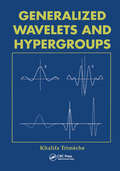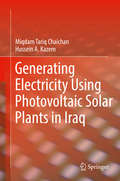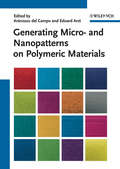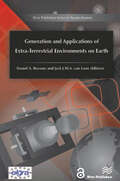- Table View
- List View
General Test Guide 2018: Pass Your Test And Know What Is Essential To Become A Safe, Competent Amt From The Most Trusted Source In Aviation Training
by A. S. A. Test ASA Test Prep BoardThe Fast Track Series is designed to prepare applicants who are seeking Federal Aviation Administration (FAA) certifications for the full range of material on each test of the series. Prospective test takers are supplied with questions that have been used in the FAA's knowledge exams for aviation mechanics along with an answer key, explanations, and references to quickly improve their comprehension and retention of the test and study materials. Learning Statement Codes (LSC) are also included, enabling students to easily interpret which subject areas are indicated as needing further study on their knowledge test reports. This volume of the series deals with the "General" section of the FAA Knowledge Requirements for Aviation Maintenance Technicians.
A General Theory of Fluid Mechanics
by Peiqing LiuThis book provides a general introduction to fluid mechanics in the form of biographies and popular science. Based on the author’s extensive teaching experience, it combines natural science and human history, knowledge inheritance and cognition law to replace abstract concepts of fluid mechanics with intuitive and understandable physical concepts. In seven chapters, it describes the development of fluid mechanics, aerodynamics, hydrodynamics, computational fluid dynamics, experimental fluid dynamics, wind tunnel and water tunnel equipment, the mystery of flight and aerodynamic principles, and leading figures in fluid mechanics in order to spark beginners’ interest and allow them to gain a comprehensive understanding of the field’s development. It also provides a list of references for further study.
General Theory of Light Propagation and Imaging Through the Atmosphere
by T. Stewart MckechnieThis book lays out a new, general theory of light propagation and imaging through Earth's turbulent atmosphere. Current theory is based on the - now widely doubted - assumption of Kolmogorov turbulence. The new theory is based on a generalized atmosphere, the turbulence characteristics of which can be established, as needed, from readily measurable properties of point-object, or star, images. The pessimistic resolution predictions of Kolmogorov theory led to lax optical tolerance prescriptions for large ground-based astronomical telescopes which were widely adhered to in the 1970s and 1980s. Around 1990, however, it became clear that much better resolution was actually possible, and Kolmogorov tolerance prescriptions were promptly abandoned. Most large telescopes built before 1990 have had their optics upgraded (e. g. , the UKIRT instrument) and now achieve, without adaptive optics (AO), almost an order of magnitude better resolution than before. As well as providing a more comprehensive and precise understanding of imaging through the atmosphere with large telescopes (both with and without AO), the new general theory also finds applications in the areas of laser communications and high-energy laser beam propagation.
General Theory of Light Propagation and Imaging Through the Atmosphere (Progress in Optical Science and Photonics #20)
by T. Stewart McKechnieThis 2nd edition lays out an updated version of the general theory of light propagation and imaging through Earth’s turbulent atmosphere initially developed in the late ‘70s and ‘80s, with additional applications in the areas of laser communications and high-energy laser beam propagation. New material includes a chapter providing a comprehensive mathematical tool set for precisely characterizing image formation with the anticipated Extremely Large Telescopes (ELTS), enabling a staggering range of star image shapes and sizes; existing chapters rewritten or modified so as to supplement the mathematics with clearer physical insight through written and graphical means; a history of the development of present-day understanding of light propagation and imaging through the atmosphere as represented by the general theory described. Beginning with the rudimentary, geometrical-optics based understanding of a century ago, it describes advances made in the 1960s, including the development of the ‘Kolmogorov theory,’ the deficiencies of which undermined its credibility, but not before it had done enormous damage, such as construction of a generation of underperforming ‘light bucket’ telescopes. The general theory requires no a priori turbulence assumptions. Instead, it provides means for calculating the turbulence properties directly from readily-measurable properties of star images.
The General Theory of Relativity
by Andrew Debenedictis Anadijiban DasThe General Theory of Relativity: A Mathematical Exposition will serve readers as a modern mathematical introduction to the general theory of relativity. Throughout the book, examples, worked-out problems, and exercises (with hints and solutions) are furnished. Topics in this book include, but are not limited to: tensor analysis the special theory of relativity the general theory of relativity and Einstein's field equations spherically symmetric solutions and experimental confirmations static and stationary space-time domains black holes cosmological models algebraic classifications and the Newman-Penrose equations the coupled Einstein-Maxwell-Klein-Gordon equations appendices covering mathematical supplements and special topics Mathematical rigor, yet very clear presentation of the topics make this book a unique text for both university students and research scholars. Anadijiban Das has taught courses on Relativity Theory at The University College of Dublin, Ireland, Jadavpur University, India, Carnegie-Mellon University, USA, and Simon Fraser University, Canada. His major areas of research include, among diverse topics, the mathematical aspects of general relativity theory. Andrew DeBenedictis has taught courses in Theoretical Physics at Simon Fraser University, Canada, and is also a member of The Pacific Institute for the Mathematical Sciences. His research interests include quantum gravity, classical gravity, and semi-classical gravity.
General Thermodynamics
by Donald OlanderBecause classical thermodynamics evolved into many branches of science and engineering, most undergraduate courses on the subject are taught from the perspective of each area of specialization. General Thermodynamics combines elements from mechanical and chemical engineering, chemistry (including electrochemistry), materials science, and biology to present a unique and thorough treatment of thermodynamics that is broader in scope than other fundamental texts.This book contains classroom-tested materials designed to meet the academic requirements for students from a variety of scientific and engineering backgrounds in a single course. The first half focuses on classical concepts of thermodynamics, whereas the latter half explores field-specific applications, including a unique chapter on biothermodynamics. The book’s methodology is unified, concise, and multidisciplinary, allowing students to understand how the principles of thermodynamics apply to all technical fields that touch upon this most fundamental of scientific theories. It also offers a rigorous approach to the quantitative aspects of thermodynamics, accompanied by clear explanations to help students transition smoothly from the physical concepts to their mathematical representations. Each chapter contains numerous worked examples taken from different engineering applications, illustrations, and an extensive set of exercises to support the material. A complete solutions manual is available to professors with qualifying course adoptions.
Generalizations of Fuzzy Information Measures
by Anshu Ohlan Ramphul OhlanThis book develops applications of novel generalizations of fuzzy information measures in the field of pattern recognition, medical diagnosis, multi-criteria and multi-attribute decision making and suitability in linguistic variables. The focus of this presentation lies on introducing consistently strong and efficient generalizations of information and information-theoretic divergence measures in fuzzy and intuitionistic fuzzy environment covering different practical examples. The target audience comprises primarily researchers and practitioners in the involved fields but the book may also be beneficial for graduate students.
Generalized Adjoint Systems
by Demetrios SerakosThis book defines and develops the generalized adjoint of an input-output system. It is the result of a theoretical development and examination of the generalized adjoint concept and the conditions under which systems analysis using adjoints is valid. Results developed in this book are useful aids for the analysis and modeling of physical systems, including the development of guidance and control algorithms and in developing simulations. The generalized adjoint system is defined and is patterned similarly to adjoints of bounded linear transformations. Next the elementary properties of the generalized adjoint system are derived. For a space of input-output systems, a generalized adjoint map from this space of systems to the space of generalized adjoints is defined. Then properties of the generalized adjoint map are derived. Afterward the author demonstrates that the inverse of an input-output system may be represented in terms of the generalized adjoint. The use of generalized adjoints to determine bounds for undesired inputs such as noise and disturbance to an input-output system is presented and methods which parallel adjoints in linear systems theory are utilized. Finally, an illustrative example is presented which utilizes an integral operator representation for the system mapping.
Generalized Barycentric Coordinates in Computer Graphics and Computational Mechanics
by Kai Hormann N. SukumarIn Generalized Barycentric Coordinates in Computer Graphics and Computational Mechanics, eminent computer graphics and computational mechanics researchers provide a state-of-the-art overview of generalized barycentric coordinates. Commonly used in cutting-edge applications such as mesh parametrization, image warping, mesh deformation, and finite as well as boundary element methods, the theory of barycentric coordinates is also fundamental for use in animation and in simulating the deformation of solid continua. Generalized Barycentric Coordinates is divided into three sections, with five chapters each, covering the theoretical background, as well as their use in computer graphics and computational mechanics. A vivid 16-page insert helps illustrating the stunning applications of this fascinating research area. <P><P>Key Features: <li>Provides an overview of the many different types of barycentric coordinates and their properties. <li>Discusses diverse applications of barycentric coordinates in computer graphics and computational mechanics. <li>The first book-length treatment on this topic
Generalized Continua as Models for Classical and Advanced Materials
by Holm Altenbach Samuel ForestThis volume is devoted to an actual topic which is the focus world-wide of various research groups. It contains contributions describing the material behavior on different scales, new existence and uniqueness theorems, the formulation of constitutive equations for advanced materials. The main emphasis of the contributions is directed on the following items - Modelling and simulation of natural and artificial materials with significant microstructure, - Generalized continua as a result of multi-scale models, - Multi-field actions on materials resulting in generalized material models, - Theories including higher gradients, and - Comparison with discrete modelling approaches
Generalized Continua as Models for Materials
by Anton Krivtsov Holm Altenbach Samuel ForestThis volume presents contributions describing the micro- and macro-behaviours, new existence and uniqueness theorems, the formulation of multi-scale problems, etc. and now it is time to ponder again the state of matter and to discuss new trends and applications. The main focus is directed on the following items - Modelling and simulation of materials with significant microstructure, - Generalized continua as a result of multi-scale models, - Multi-field actions on materials resulting in generalized material models, and - Comparison with discrete modelling approaches
Generalized Dynamics of Soft-Matter Quasicrystals: Mathematical Models, Solutions and Applications (Springer Series in Materials Science #260)
by Tian-You Fan Wenge Yang Hui Cheng Xiao-Hong SunThis book highlights the mathematical models and solutions of the generalized dynamics of soft-matter quasicrystals (SMQ) and introduces possible applications of the theory and methods. Based on the theory of quasiperiodic symmetry and symmetry breaking, the book treats the dynamics of individual quasicrystal systems by reducing them to nonlinear partial differential equations and then provides methods for solving the initial-boundary value problems in these equations. The solutions obtained demonstrate the distribution, deformation and motion of SMQ and determine the stress, velocity and displacement fields. The interactions between phonons, phasons and fluid phonons are discussed in some fundamental materials samples. The reader benefits from a detailed comparison of the mathematical solutions for both solid and soft-matter quasicrystals, gaining a deeper understanding of the universal properties of SMQ. The second edition covers the latest research progress on quasicrystals in topics such as thermodynamic stability, three-dimensional problems and solutions, rupture theory, and the photonic band-gap and its applications. These novel chapters make the book an even more useful and comprehensive reference guide for researchers in condensed matter physics, chemistry and materials sciences.
The Generalized Fourier Series Method: Bending of Elastic Plates (Developments in Mathematics #65)
by Christian Constanda Dale DotyThis book explains in detail the generalized Fourier series technique for the approximate solution of a mathematical model governed by a linear elliptic partial differential equation or system with constant coefficients. The power, sophistication, and adaptability of the method are illustrated in application to the theory of plates with transverse shear deformation, chosen because of its complexity and special features. In a clear and accessible style, the authors show how the building blocks of the method are developed, and comment on the advantages of this procedure over other numerical approaches. An extensive discussion of the computational algorithms is presented, which encompasses their structure, operation, and accuracy in relation to several appropriately selected examples of classical boundary value problems in both finite and infinite domains. The systematic description of the technique, complemented by explanations of the use of the underlying software, will help the readers create their own codes to find approximate solutions to other similar models. The work is aimed at a diverse readership, including advanced undergraduates, graduate students, general scientific researchers, and engineers.The book strikes a good balance between the theoretical results and the use of appropriate numerical applications. The first chapter gives a detailed presentation of the differential equations of the mathematical model, and of the associated boundary value problems with Dirichlet, Neumann, and Robin conditions. The second chapter presents the fundamentals of generalized Fourier series, and some appropriate techniques for orthonormalizing a complete set of functions in a Hilbert space. Each of the remaining six chapters deals with one of the combinations of domain-type (interior or exterior) and nature of the prescribed conditions on the boundary. The appendices are designed to give insight into some of the computational issues that arise from the use of the numerical methods described in the book.Readers may also want to reference the authors’ other books Mathematical Methods for Elastic Plates, ISBN: 978-1-4471-6433-3 and Boundary Integral Equation Methods and Numerical Solutions: Thin Plates on an Elastic Foundation, ISBN: 978-3-319-26307-6.
Generalized Homogeneity in Systems and Control (Communications and Control Engineering)
by Andrey PolyakovThis monograph introduces the theory of generalized homogeneous systems governed by differential equations in both Euclidean (finite-dimensional) and Banach/Hilbert (infinite-dimensional) spaces. It develops methods of stability and robustness analysis, control design, state estimation and discretization of homogeneous control systems. Generalized Homogeneity in Systems and Control is structured in two parts. Part I discusses various models of control systems and related tools for their analysis, including Lyapunov functions. Part II deals with the analysis and design of homogeneous control systems. Some of the key features of the text include: mathematical models of dynamical systems in finite-dimensional and infinite-dimensional spaces; the theory of linear dilations in Banach spaces;homogeneous control and estimation;simple methods for an "upgrade" of existing linear control laws; numerical schemes for a consistent digital implementation of homogeneous algorithms; and experiments confirming an improvement of PID controllers. The advanced mathematical material will be of interest to researchers, mathematicians working in control theory and mathematically oriented control engineers.
Generalized Linear Mixed Models with Applications in Agriculture and Biology
by Josafhat Salinas Ruíz Osval Antonio Montesinos López Gabriela Hernández Ramírez Jose Crossa HiriartThis open access book offers an introduction to mixed generalized linear models with applications to the biological sciences, basically approached from an applications perspective, without neglecting the rigor of the theory. For this reason, the theory that supports each of the studied methods is addressed and later - through examples - its application is illustrated. In addition, some of the assumptions and shortcomings of linear statistical models in general are also discussed. An alternative to analyse non-normal distributed response variables is the use of generalized linear models (GLM) to describe the response data with an exponential family distribution that perfectly fits the real response. Extending this idea to models with random effects allows the use of Generalized Linear Mixed Models (GLMMs). The use of these complex models was not computationally feasible until the recent past, when computational advances and improvements to statistical analysis programs allowed users to easily, quickly, and accurately apply GLMM to data sets. GLMMs have attracted considerable attention in recent years. The word "Generalized" refers to non-normal distributions for the response variable and the word "Mixed" refers to random effects, in addition to the fixed effects typical of analysis of variance (or regression). With the development of modern statistical packages such as Statistical Analysis System (SAS), R, ASReml, among others, a wide variety of statistical analyzes are available to a wider audience. However, to be able to handle and master more sophisticated models requires proper training and great responsibility on the part of the practitioner to understand how these advanced tools work. GMLM is an analysis methodology used in agriculture and biology that can accommodate complex correlation structures and types of response variables.
Generalized Measure Theory
by Zhenyuan Wang George J. KlirGeneralized Measure Theory examines the relatively new mathematical area of generalized measure theory. The exposition unfolds systematically, beginning with preliminaries and new concepts, followed by a detailed treatment of important new results regarding various types of nonadditive measures and the associated integration theory. The latter involves several types of integrals: Sugeno integrals, Choquet integrals, pan-integrals, and lower and upper integrals. All of the topics are motivated by numerous examples, culminating in a final chapter on applications of generalized measure theory. Some key features of the book include: many exercises at the end of each chapter along with relevant historical and bibliographical notes, an extensive bibliography, and name and subject indices. The work is suitable for a classroom setting at the graduate level in courses or seminars in applied mathematics, computer science, engineering, and some areas of science. A sound background in mathematical analysis is required. Since the book contains many original results by the authors, it will also appeal to researchers working in the emerging area of generalized measure theory.
The Generalized Multipole Technique for Light Scattering: Recent Developments (Springer Series on Atomic, Optical, and Plasma Physics #99)
by Thomas Wriedt Yuri EreminThis book presents the Generalized Multipole Technique as a fast and powerful theoretical and computation tool to simulate light scattering by nonspherical particles. It also demonstrates the considerable potential of the method. In recent years, the concept has been applied in new fields, such as simulation of electron energy loss spectroscopy and has been used to extend other methods, like the null-field method, making it more widely applicable. The authors discuss particular implementations of the GMT methods, such as the Discrete Sources Method (DSM), Multiple Multipole Program (MMP), the Method of Auxiliary Sources (MAS), the Filamentary Current Method (FCM), the Method of Fictitious Sources (MFS) and the Null-Field Method with Discrete Sources (NFM-DS). The Generalized Multipole Technique is a surface-based method to find the solution of a boundary-value problem for a given differential equation by expanding the fields in terms of fundamental or other singular solutions of this equation. The amplitudes of these fundamental solutions are determined from the boundary condition at the particle surface. Electromagnetic and light scattering by particles or systems of particles has been the subject of intense research in various scientific and engineering fields, including astronomy, optics, meteorology, remote sensing, optical particle sizing and electromagnetics, which has led to the development of a large number of modelling methods based on the Generalized Multipole Technique for quantitative evaluation of electromagnetic scattering by particles of various shapes and compositions. The book describes these methods in detail.
Generalized Notions of Continued Fractions: Ergodicity and Number Theoretic Applications (Chapman & Hall/CRC Monographs and Research Notes in Mathematics)
by Juan Fernández Sánchez Jerónimo López-Salazar Codes Juan B. Seoane Sepúlveda Wolfgang TrutschnigAncient times witnessed the origins of the theory of continued fractions. Throughout time, mathematical geniuses such as Euclid, Aryabhata, Fibonacci, Bombelli, Wallis, Huygens, or Euler have made significant contributions to the development of this famous theory, and it continues to evolve today, especially as a means of linking different areas of mathematics.This book, whose primary audience is graduate students and senior researchers, is motivated by the fascinating interrelations between ergodic theory and number theory (as established since the 1950s). It examines several generalizations and extensions of classical continued fractions, including generalized Lehner, simple, and Hirzebruch-Jung continued fractions. After deriving invariant ergodic measures for each of the underlying transformations on [0,1] it is shown that any of the famous formulas, going back to Khintchine and Levy, carry over to more general settings. Complementing these results, the entropy of the transformations is calculated and the natural extensions of the dynamical systems to [0,1]2 are analyzed. Features Suitable for graduate students and senior researchers Written by international senior experts in number theory Contains the basic background, including some elementary results, that the reader may need to know before hand, making it a self-contained volume
Generalized Perturbations in Modified Gravity and Dark Energy
by Jonathan PearsonWhen predictions of Einstein's theory of General Relativity are compared against observations of our Universe, a huge inconsistency is found. The most popular fix for this inconsistency is to "invent" around 94% of the content of the universe: dark matter and dark energy. The dark energy is some exotic substance responsible for the apparent observed acceleration of the Universe. Another fix is to modify the theory of gravity: it is entirely plausible that Einstein's theory of General Relativity breaks down on cosmological scales, just as Newton's theory of gravity breaks down in the extreme gravitational field of the Sun. There are many alternative theories of gravity, each with the aim of describing observations of our Universe where General Relativity fails. Whether it is dark energy or some modified theory of gravity, it is clear that there is some "dark sector" in the Universe. In this thesis the author constructs a unifying framework for understanding the observational impact of general classes of dark sector theories, by formulating equations of state for the dark sector perturbations.
Generalized Predictive Control And Bioengineering (Series in Systems and Control)
by M Mahfouf D. A. LinkensPredictive control is a powerful tool in dealing with those processes with large time delays. Generalized Predictive Control GPC is the most popular approach to the subject, and this text discusses the application of GPC starting with the concept of long-range predictive control and its need in medicine particularly automated drug deliveries.; The concept of adaptation is also emphasized with respect to patient-to-patient parameter variations. Subsequent chapters discuss interactions, comparisons and various aspects of GPC. The book concludes by putting into perspective the generic nature of the architecture built around GPC and which provides model-based fault diagnosis with control.
Generalized Statistical Thermodynamics: Thermodynamics of Probability Distributions and Stochastic Processes (Understanding Complex Systems)
by Themis MatsoukasThis book gives the definitive mathematical answer to what thermodynamics really is: a variational calculus applied to probability distributions. Extending Gibbs's notion of ensemble, the Author imagines the ensemble of all possible probability distributions and assigns probabilities to them by selection rules that are fairly general. The calculus of the most probable distribution in the ensemble produces the entire network of mathematical relationships we recognize as thermodynamics. The first part of the book develops the theory for discrete and continuous distributions while the second part applies this thermodynamic calculus to problems in population balance theory and shows how the emergence of a giant component in aggregation, and the shattering transition in fragmentation may be treated as formal phase transitions. While the book is intended as a research monograph, the material is self-contained and the style sufficiently tutorial to be accessible for self-paced study by an advanced graduate student in such fields as physics, chemistry, and engineering.
Generalized Wavelets and Hypergroups
by Khalifa TrimecheWavelets have recently been enjoying a period of popularity and rapid growth, and the influence of wavelet methods now extends well beyond mathematics into a number of practical fields, including statistics. The theory of hypergroups can be traced back to the turn of the century, and following its formalization in the early 1970s, the area has now
Generating Electricity Using Photovoltaic Solar Plants in Iraq
by Miqdam Tariq Chaichan Hussein A. KazemThis book focuses on solar energy and its applications in Iraq and its neighboring countries. Iraq suffers from electricity shortages and faces many challenges to meet and overcome current and future increases in electrical demand. Although Iraq relies primarily on petroleum as an energy source, many scientists agree that the future of energy efficiency and safety will rely heavily on the implementation of green and renewable energies. This book is aimed at researchers, policymakers, and students and discusses how PV systems can be successfully implemented in order to reduce dependency on fossil fuel resources.Contains case studies and examples to enhance practical application of the technologies presented;Presents actual adopted Iraqi PV projects;Explains the use and application of photovoltaic cells.
Generating Micro- and Nanopatterns on Polymeric Materials
by Aránzazu Del Campo Eduard ArztNew micro and nanopatterning technologies have been developed in the last years as less costly and more flexible alternatives to phtolithograpic processing. These technologies have not only impacted on recent developments in microelectronics, but also in emerging fields such as disposable biosensors, scaffolds for tissue engineering, non-biofouling coatings, high adherence devices, or photonic structures for the visible spectrum. This handbook presents the current processing methods suitable for the fabrication of micro- and nanostructured surfaces made out of polymeric materials. It covers the steps and materials involved, the resulting structures, and is rounded off by a part on applications. As a result, chemists, material scientists, and physicists gain a critical understanding of this topic at an early stage of its development.
Generation and Applications of Extra-Terrestrial Environments on Earth (River Publishers Series In Standardisation Ser.)
by Daniel A. Beysens Jack J. W. A. van LoonThis book has been prepared under the auspice of the European Low Gravity Research Association (ELGRA). The main task of ELGRA is to foster the scientific community in Europe and beyond in conducting gravity and space-related research.This publication is dedicated to the science community, and especially to the next generation of scientists and engineers interested in space research and in the means to use Earth to reproduce the space environment. ELGRA provides a comprehensive description of space conditions and the means that have been developed on Earth to perform space environmental and (micro-) gravity related research. .The book covers ground-based research instruments and environments for both life and physical sciences research. It discusses the opportunities and limitations of protocols and instruments to compensate gravity or simulate microgravity, such as clinostats, random positioning machines, levitating magnets, electric fields, vibrations, tail suspension or head down tilt, as well as centrifuges for hyper-g studies. Other space environmental conditions are addressed too, like cosmic radiation or Mars atmospheric and soil properties to be replicated and simulated on Earth. Future long duration of manned missions, personal well-being and crew interaction are major issues dealt with.
